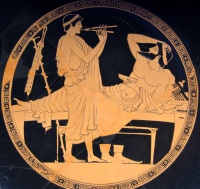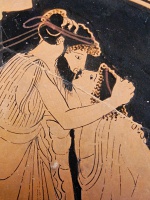Kottabos: Difference between revisions
No edit summary |
|||
| (13 intermediate revisions by the same user not shown) | |||
| Line 1: | Line 1: | ||
{{History}} | {{History}} | ||
'''Kottabos''' (Ancient Greek: κότταβος) was a game of skill played at ancient [[Ancient Greece|Greek]] and [[Etruscan society|Etruscan]] [[symposium|symposia (drinking parties)]], especially in the 5th and 4th centuries BC. The game is played by flinging wine lees at targets. The player would utter the name of the object of his affection.<ref>[http://www.powerhousemuseum.com/collection/database/?irn=166498&img=141685 99/117/1 Drinking cup (kylix), red-figure style, glazed terracotta, attributed to the Antiphon Painter, Athens, Greece, c. 490–480 BCE – Powerhouse Museum Collection | '''Kottabos''' (Ancient Greek: κότταβος) was a game of skill played at ancient [[Ancient Greece|Greek]] and [[Etruscan society|Etruscan]] [[symposium|symposia (drinking parties)]], especially in the 5th and 4th centuries BC. The game is played by flinging wine lees at targets. The player would utter the name of the object of his affection.<ref>[http://www.powerhousemuseum.com/collection/database/?irn=166498&img=141685 99/117/1 Drinking cup (kylix), red-figure style, glazed terracotta, attributed to the Antiphon Painter, Athens, Greece, c. 490–480 BCE – Powerhouse Museum Collection]</ref> The game appears to have been of Sicilian origin, but it spread through Greece from Thessaly to Rhodes, and was especially fashionable at [[Athens]]. | ||
==Forms of play== | |||
The object of the player was to cast a portion of wine left in his drinking cup, in such a way that it doesn't break bulk in its passage through the air, towards a bronze "lamp stand" with a tiny statuette on top with outstretched arms delicately holding a small disc called a ''[[plastinx]]''. Halfway down the stand was a larger disc called the ''[[manes]]''. To be successful the player had to knock off the ''plastinx'' in such a way that it would fall to the ''manes'' and make a bell like sound.<ref>Hugh Johnson, ''Vintage: The Story of Wine'' pg 44. Simon and Schuster 1989</ref> Both the wine thrown and the noise made were called ''[[latax]]'' (''λάταξ''). The thrower, in the ordinary form of the game, was expected to retain the recumbent position that was usual at table, and, in flinging the cottabus, to make use of his right hand only. | The object of the player was to cast a portion of wine left in his drinking cup, in such a way that it doesn't break bulk in its passage through the air, towards a bronze "lamp stand" with a tiny statuette on top with outstretched arms delicately holding a small disc called a ''[[plastinx]]''. Halfway down the stand was a larger disc called the ''[[manes]]''. To be successful the player had to knock off the ''plastinx'' in such a way that it would fall to the ''manes'' and make a bell like sound.<ref>Hugh Johnson, ''Vintage: The Story of Wine'' pg 44. Simon and Schuster 1989</ref> Both the wine thrown and the noise made were called ''[[latax]]'' (''λάταξ''). The thrower, in the ordinary form of the game, was expected to retain the recumbent position that was usual at table, and, in flinging the cottabus, to make use of his right hand only. | ||
To succeed in the aim of the game dexterity was required, and unusual ability in the game was rated as high as corresponding excellence in throwing the [[Pilum|javelin]]. Not only was the cottabus the ordinary accompaniment of the festal assembly, but, at least in [[Sicily]], a special building of a circular form was sometimes erected so that the players might be easily arranged round the basin, and follow each other in rapid succession. Like all games in which the element of chance found a place, it was regarded as more or less ominous of the future success of the players, especially in matters of love – and the excitement was sometimes further augmented by some object of value being staked on the event. | To succeed in the aim of the game dexterity was required, and unusual ability in the game was rated as high as corresponding excellence in throwing the [[Pilum|javelin]]. Not only was the cottabus the ordinary accompaniment of the festal assembly, but, at least in [[Sicily]], a special building of a circular form was sometimes erected so that the players might be easily arranged round the basin, and follow each other in rapid succession. Like all games in which the element of chance found a place, it was regarded as more or less ominous of the future success of the players, especially in matters of love – and the excitement was sometimes further augmented by some object of value being staked on the event. | ||
[[File:800px-Symposiumnorthwall.jpg|thumb|left|650px|[[Symposium]] scene with Kottabos player (center). Fresco from the [[Tomb of the Diver]]. 475 BC. <BR>Paestum National Museum, Italy.]] | |||
<br> | |||
<br> | |||
==Variations== | ==Variations== | ||
| Line 21: | Line 39: | ||
Sunken cottabus (Κότταβος κατακτός) is not so simple. The apparatus ''(kottabeion, pl. kottabeia)''<ref>Herman W. Hayley, "The kottabos kataktos in the Light of Recent Investigations", ''Harvard Studies in Classical Philology,'' Vol. 5, 1894 (1894), pp. 73–82</ref> involved consisted of the rhabdus (ῥάβδος, a bronze pole), the plastinx (πλάστιγξ, a small saucer like that on a balance), the lecanis (λεκανίς, a large saucer), and the manes (μάνης, a bronze figurine). | Sunken cottabus (Κότταβος κατακτός) is not so simple. The apparatus ''(kottabeion, pl. kottabeia)''<ref>Herman W. Hayley, "The kottabos kataktos in the Light of Recent Investigations", ''Harvard Studies in Classical Philology,'' Vol. 5, 1894 (1894), pp. 73–82</ref> involved consisted of the rhabdus (ῥάβδος, a bronze pole), the plastinx (πλάστιγξ, a small saucer like that on a balance), the lecanis (λεκανίς, a large saucer), and the manes (μάνης, a bronze figurine). | ||
The discovery in Etruscan burial sites (by | The discovery in Etruscan burial sites (by Wolfgang Helbig in 1886) of two sets of actual apparatus in Umbria, near Perugia, as well as various representations on Greek vases help explain the somewhat obscure accounts<ref>These accounts, contained in the writings of various Greek and Roman authors, should not be assumed as entirely accurate since they were written at a time when cottabus had, in fact, become obsolete</ref> of how cottabus was played. | ||
The rhabdus (pole) had a flat base, and the main structure tapered towards the top, with a blunt end (one which the plastinx or manes was balanced). The plastinx (small saucer) had a hole near the edge and was slightly concave in the middle. | The rhabdus (pole) had a flat base, and the main structure tapered towards the top, with a blunt end (one which the plastinx or manes was balanced). The plastinx (small saucer) had a hole near the edge and was slightly concave in the middle. | ||
| Line 42: | Line 60: | ||
* [[Symposium]] | * [[Symposium]] | ||
==References== | |||
{{reflist}} | |||
==Notes== | ==Notes== | ||
** Sartoris, C. ''Das Kottabos-Spiel der alten Griechen''. 1893. A complete treatise on the subject with a full bibliography of ancient and more modern authorities. | ** Sartoris, C. ''Das Kottabos-Spiel der alten Griechen''. 1893. A complete treatise on the subject with a full bibliography of ancient and more modern authorities. | ||
** Higgins, A. “Recent Discoveries of the Apparatus used in playing the Game of Kottabos.” ''Archaeologia'', li. 1888. | ** Higgins, A. “Recent Discoveries of the Apparatus used in playing the Game of Kottabos.” ''Archaeologia'', li. 1888. | ||
| Line 54: | Line 72: | ||
==External links== | ==External links== | ||
* [http://www.ancientlibrary.com/smith-dgra/index.html Smith, ''Dictionary of Greek and Roman Antiquities''] (pp. 366–367). | * [http://www.ancientlibrary.com/smith-dgra/index.html Smith, ''Dictionary of Greek and Roman Antiquities''] (pp. 366–367). | ||
{{Navbox Ancient Greece}} | |||
[[Category:Ancient Greece]] | [[Category:Ancient Greece]] | ||
[[Category:Drinking games]] | [[Category:Drinking games]] | ||
[[Category:sports]] | [[Category:sports]] | ||
Latest revision as of 22:42, 2 July 2022
| Part of the boylove history series |
 |
| Portal:History |
Kottabos (Ancient Greek: κότταβος) was a game of skill played at ancient Greek and Etruscan symposia (drinking parties), especially in the 5th and 4th centuries BC. The game is played by flinging wine lees at targets. The player would utter the name of the object of his affection.[1] The game appears to have been of Sicilian origin, but it spread through Greece from Thessaly to Rhodes, and was especially fashionable at Athens.
Forms of play
The object of the player was to cast a portion of wine left in his drinking cup, in such a way that it doesn't break bulk in its passage through the air, towards a bronze "lamp stand" with a tiny statuette on top with outstretched arms delicately holding a small disc called a plastinx. Halfway down the stand was a larger disc called the manes. To be successful the player had to knock off the plastinx in such a way that it would fall to the manes and make a bell like sound.[2] Both the wine thrown and the noise made were called latax (λάταξ). The thrower, in the ordinary form of the game, was expected to retain the recumbent position that was usual at table, and, in flinging the cottabus, to make use of his right hand only.
To succeed in the aim of the game dexterity was required, and unusual ability in the game was rated as high as corresponding excellence in throwing the javelin. Not only was the cottabus the ordinary accompaniment of the festal assembly, but, at least in Sicily, a special building of a circular form was sometimes erected so that the players might be easily arranged round the basin, and follow each other in rapid succession. Like all games in which the element of chance found a place, it was regarded as more or less ominous of the future success of the players, especially in matters of love – and the excitement was sometimes further augmented by some object of value being staked on the event.

Paestum National Museum, Italy.
Variations
Various modifications of the original principle of the game were gradually introduced, but for practical purposes we may reckon two varieties:
Cottabus with an oxybaphon
In cottabus with an oxybaphon (Κότταβος δι᾽ ὀξυβάφων), shallow saucers (ὀξύβαφα or "oxybapha") were floated in a basin or mixing-bowl filled with water; the object was to sink each oxybaphon by throwing the wine into it. The competitor who sank the greatest number was considered victorious, and received the prize (κοττάβιον or "cottabium"), which consisted of cakes or sweetmeats.
Sunken cottabus

Sunken cottabus (Κότταβος κατακτός) is not so simple. The apparatus (kottabeion, pl. kottabeia)[3] involved consisted of the rhabdus (ῥάβδος, a bronze pole), the plastinx (πλάστιγξ, a small saucer like that on a balance), the lecanis (λεκανίς, a large saucer), and the manes (μάνης, a bronze figurine).
The discovery in Etruscan burial sites (by Wolfgang Helbig in 1886) of two sets of actual apparatus in Umbria, near Perugia, as well as various representations on Greek vases help explain the somewhat obscure accounts[4] of how cottabus was played.
The rhabdus (pole) had a flat base, and the main structure tapered towards the top, with a blunt end (one which the plastinx or manes was balanced). The plastinx (small saucer) had a hole near the edge and was slightly concave in the middle.
About two-thirds of the way down, the rhabdus was encircled by the lecanis (large saucer). A socket near the top of the rhabdus held the manes (figurine). The manes was in the shape of a man, with his right arm and leg uplifted, sometimes holding a drinking horn (or "rhytum").
According to Helbig, three games[5] were played with this apparatus:
Method No. 1
The plastinx (small saucer) was fixed on top of the rhabdus (pole), with the lecanis (large saucer) below. The players tried to fill the plastinx with enough wine to tip it over (with a crash) onto the lecanis.
Method No. 2
Played exactly the same as method No. 1, except that the plastinx was supposed to hit the manes (figurine) on the way down to the lecanis.
Method No. 3
Played exactly the same as method No. 1, except that the manes (instead of the plastinx) was fixed on top of the rhabdus, and it was at this that the wine was thrown.
See also
References
- ↑ 99/117/1 Drinking cup (kylix), red-figure style, glazed terracotta, attributed to the Antiphon Painter, Athens, Greece, c. 490–480 BCE – Powerhouse Museum Collection
- ↑ Hugh Johnson, Vintage: The Story of Wine pg 44. Simon and Schuster 1989
- ↑ Herman W. Hayley, "The kottabos kataktos in the Light of Recent Investigations", Harvard Studies in Classical Philology, Vol. 5, 1894 (1894), pp. 73–82
- ↑ These accounts, contained in the writings of various Greek and Roman authors, should not be assumed as entirely accurate since they were written at a time when cottabus had, in fact, become obsolete
- ↑ A fourth method, in which a set of scales was barraged with wine so that each side of the scale would dip down and touch an image placed underneath, probably never existed and was conceived by a confusion of the plastinx with a scale-pan by reason of its name (which also means "scale" in Greek).
Notes
- Sartoris, C. Das Kottabos-Spiel der alten Griechen. 1893. A complete treatise on the subject with a full bibliography of ancient and more modern authorities.
- Higgins, A. “Recent Discoveries of the Apparatus used in playing the Game of Kottabos.” Archaeologia, li. 1888.
- Daremberg and Saglios. “Kottabos.” Dictionnaire des antiquités
- de Fouquières, L. Becq. Les Jeux des anciens. 1873.
- Helbig, Wolfgang. Mitteilungen des Deutschen Archäologischen Instituts. Römische Abteilung i. 1886.
External links
- Smith, Dictionary of Greek and Roman Antiquities (pp. 366–367).
